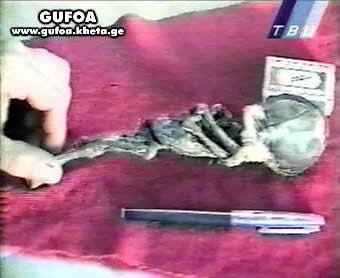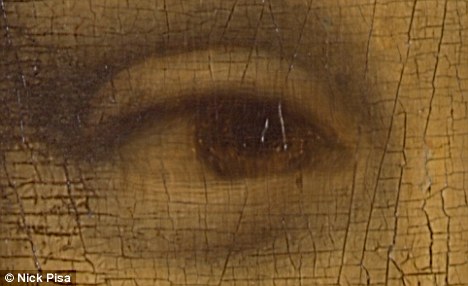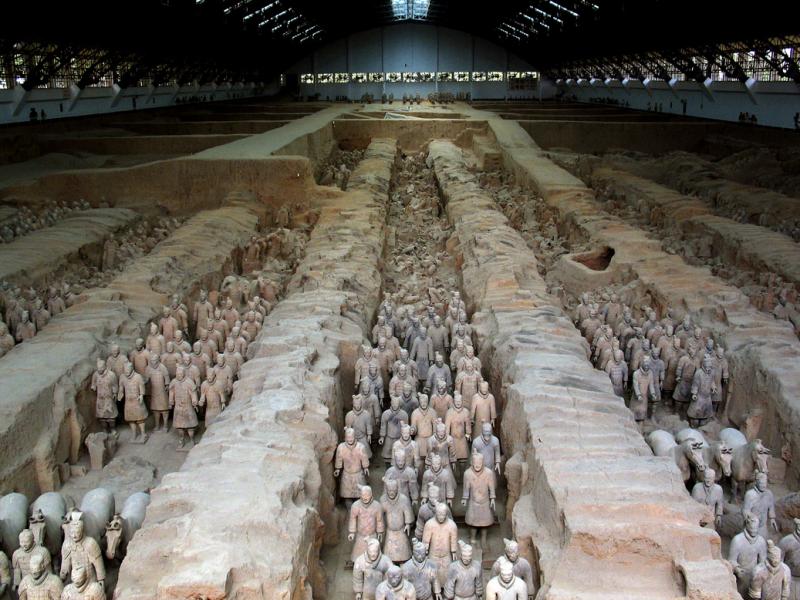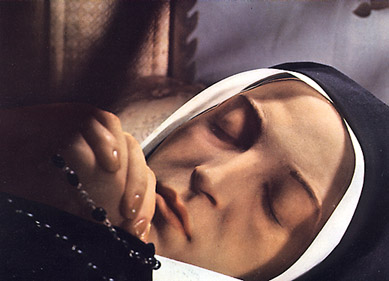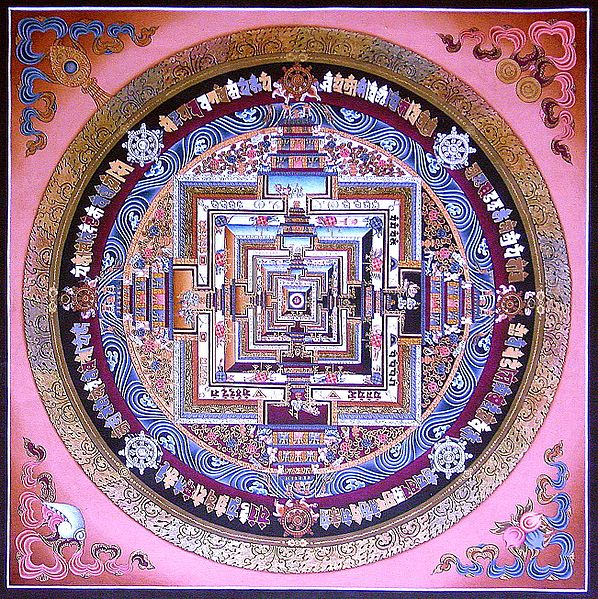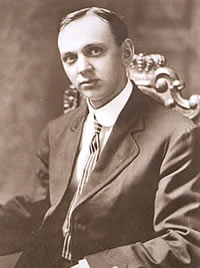Mysterious dwarfish alien brutally murdered in Russia's remote village
Researchers looking into the case of “Alionshenka the Alien” have arrived at a sensational conclusion: the mysterious creature did not catch his death of cold as previously thought. They believe the supposed alien was killed.
“He didn’t die from natural causes,” said Vadim Chernobrov, a coordinator with the public research center Kosmopoisk. “We found out that his skull had been fractured,” Chernobrov added.
The mysterious dwarf was found near the town of Kyshtym of the Chelyabinsk region. Stanislav Samoshkin is a morbid anatomist who performed autopsy on the body of the dwarf in a local hospital. He was the first to claim that the creature was a non-human being.
“The human skull consists of six bones. The skull of that creature was made up of four bones,” Samoshkin said.
Russian and foreign researchers have been trying to unravel the mystery of the “Uralian alien” for eleven years. The story looks like a detective novel in progress. The body of the dwarf was reportedly stolen. The key witness to the case, an old woman who actually named the dwarf “Alioshenka”, died a sudden death.
Researchers believe that Tamara’s account is a true story. She has been repeating it word by word for years without adding up any new details.
“He was giving off that smell, you know, one of a kind. You can’t take it for any other smell. Actually, the smell was pretty agreeable yet somewhat nauseous at the same time. And he didn’t pass any liquid or solid waste matter. He was sweating, and that was all. I saw the mother-in-law wipe the sweat off his face with a rag,” Tamara added.
The old woman died in a hit-and-run accident in August 1999. She was knocked down by a car just a few days before a team of researchers arrived in the town from Moscow. Researchers phoned her relatives shortly before the accident occured. Academician Mark Milkhiker was going to put Prosvirina in a state of hypnosis, a method used for helping the patient recover information buried in his subconscious.
Prosvirina’s relatives are confident that the death of the old woman was not an accident.
“You can hardly see a vehicle crossing this town during the day. Where the hell did that car come from?” Tamara asked.
Read more at Alionshenka-the-Alien - Russian 'Kyshtym' Alien
Wednesday, December 22, 2010
Monday, December 13, 2010
Mona Lisa's Eyes Reveal Code
Art detectives have discovered tiny letters and numbers placed in the eyes of the Mona Lisa.
Like something out of Dan Brown's Da Vinci Code the tiny letters have been identified for the first time under magnification, in the right eye the letters spell out Da Vinci's own initials LV suggesting that he placed them there deliberately.
Intrigue is usually focused on her enigmatic smile.
But the Mona Lisa was at the centre of a new mystery yesterday after art detectives took a fresh look at the masterpiece – and noticed something in her eyes.
Hidden in the dark paint of her pupils are tiny letters and numbers, placed there by the artist Leonardo da Vinci and revealed only now thanks to high-magnification techniques.
Experts say the barely distinguishable letters and numbers represent something of a real-life Da Vinci code.
The revelation could have come straight from the pages of Dan Brown’s best-seller The Da Vinci Code, in which the Mona Lisa is said to contain hidden clues about the Holy Grail.
Silvano Vinceti, president of Italy’s National Committee for Cultural Heritage, which spotted the symbols, said: ‘To the naked eye the symbols are not visible but with a magnifying glass they can clearly be seen.
‘In the right eye appear to be the letters LV which could well stand for his name, Leonardo da Vinci, while in the left eye there are also symbols but they are not as defined.
‘It is very difficult to make them out clearly but they appear to be the letters CE, or it could be the letter B.
‘In the arch of the bridge in the background the number 72 can be seen or it could be an L and the number 2.
‘You have to remember the picture is almost 500 years old so it is not as sharp and clear as when first painted.
‘From the preliminary investigations we have carried out we are confident they are not a mistake and were put there by the artist.
Read more at Mona Lisa Mystery
Like something out of Dan Brown's Da Vinci Code the tiny letters have been identified for the first time under magnification, in the right eye the letters spell out Da Vinci's own initials LV suggesting that he placed them there deliberately.
Intrigue is usually focused on her enigmatic smile.
But the Mona Lisa was at the centre of a new mystery yesterday after art detectives took a fresh look at the masterpiece – and noticed something in her eyes.
Hidden in the dark paint of her pupils are tiny letters and numbers, placed there by the artist Leonardo da Vinci and revealed only now thanks to high-magnification techniques.
Experts say the barely distinguishable letters and numbers represent something of a real-life Da Vinci code.
The revelation could have come straight from the pages of Dan Brown’s best-seller The Da Vinci Code, in which the Mona Lisa is said to contain hidden clues about the Holy Grail.
Silvano Vinceti, president of Italy’s National Committee for Cultural Heritage, which spotted the symbols, said: ‘To the naked eye the symbols are not visible but with a magnifying glass they can clearly be seen.
‘In the right eye appear to be the letters LV which could well stand for his name, Leonardo da Vinci, while in the left eye there are also symbols but they are not as defined.
‘It is very difficult to make them out clearly but they appear to be the letters CE, or it could be the letter B.
‘In the arch of the bridge in the background the number 72 can be seen or it could be an L and the number 2.
‘You have to remember the picture is almost 500 years old so it is not as sharp and clear as when first painted.
‘From the preliminary investigations we have carried out we are confident they are not a mistake and were put there by the artist.
Read more at Mona Lisa Mystery
The Underground Army of Terracotta Warriors
An old Chinese saying says, “treat death as life.” In China, rulers took this saying very seriously. After death they were buried with lavish supplies of dishes, food, silk and musical instruments. In earlier times living things such as wives, servants, or pets were also buried with the Emperor, often still alive. The afterlife was so important to people because it was believed to be a prolongation of life. Everything that was buried in the tomb was thought to be a necessity for one who wanted to be prepared for a grand afterlife. In Lintong County, thirty-five kilometers east of the Chinese city Xi’an, a tomb was found that contained a whole army, armed and ready for battle. This army was created for burial complex of the first Emperor of China, Emperor Qin Shihuang .
Qin Shihuang was the first emperor of the Qin dynasty. He was known as a great leader and a conqueror of many lands. He was a destroyer, a builder, and an unforgiving tyrant. Qin Shihuang's accomplishments turned China into a great empire. He formed a centralized government, standardized the Chinese currency and script, and set up a code of laws. He also uniformed the system of measures and built many roads. One of his greatest accomplishments is considered to be constructing and building one half of what today is the Great Wall of China. While the pits with Qin Shihuangs imperial army has been dug up, the actual tomb has not. The supposed contents of the mausoleum are by the tellings of the grand historian, Sima Qian.
In his historical records dated 1 B.C Sima Qian described how the tomb was made and what was put inside it. A project to uncover the tomb though, was started a few years ago but because of a lack of funds, it came to a screeching halt. Yuan Zhongyi is the head of a small group of archaeologists working on the site of the tomb. So far, only a fifth of the fifty-one square mile tomb has been uncovered. Scientific know-how and reliable technology are scarce making it even harder to fund the excavation of the mausoleum.
Many perishable items such as silk and wood have remained inside the tomb for almost two thousand years. The tomb would answer many questions formed by the mysterious terra-cotta army. The army was actually not meant to be seen. It was made to be a “spirit army” and was not intended for display. Inside the pits it was noticed that all the figures face east. They were thought to be this way because Qin had many armies in the east that he had conquered and could have been suspicious of them. He would have wanted to be ready for battle, even in death. All the pits put together represent Qin Shihaung’s actual imperial guards that were stationed at the east of the capitol. The layout of the soldiers and horses were a replica of what Qin’s Imperial army looked like during his reign from 221—210 BC.
The first pit is thought to be the right-wing infantry division. The second was the left-wing cavalry division. Pit number three was the command unit and the fourth pit was thought to be the central force. The first life-size terra-cotta figure was discovered in the 1920’s. A Chinese peasant was digging a well and came upon it. The water disappeared suddenly from the well and the peasant, thinking this was a sign of evil, quickly re-covered what he had dug. The soldier, once again, was buried. It wasn't found again until the 1970’s when archeologists dug up what was soon to be the first actual pit discovered.
The first pit was discovered in 1974. It is the largest of the four pits and covers almost four acres. It is five meters deep and contains eleven parallel corridors and nine access ramps on the sides . There are nearly 6,000 military men inside the first pit. They make up all parts of the army such as bowmen, archers, charioteers, men with arms, and men without arms. They stand in a contemporary military formation made up of 4 parts; the vanguard, the main force, the outer flanks, and the rear guard. The main force contains six horse-drawn wooden chariots with charioteers. Horses that are about 1.5 meters high and 2 meters long lead these chariots. Over the first pit is the exhibition hall of the museum for Qin Shihuang’s terra-cotta warriors. It is about 230 meters long and has a roof made of glass to allow the sunlight to illuminate the army and horses.
Read more at Unsolved Mysteries of Terracotta Warriors
Tuesday, December 7, 2010
The Incorruptibles
Incorruptibility is a Roman Catholic belief that supernatural intervention allows some human bodies to avoid the normal process of decomposition after death. Bodies that reportedly undergo little or no decomposition, or delayed decomposition, and are sometimes referred to as incorrupt or incorruptible or as an incorruptible. Although it is recognised as supernatural in Roman Catholicism, it is no longer counted as a miracle in the recognition of a saint.
Incorruptibility is seen as distinct from the good preservation of a body, or mummification. Incorruptible bodies are often said to have the odour of sanctity, exuding a sweet or floral, pleasant aroma. As of yet, none of these cases has been verified scientifically.
Incorruptibles are the bodies of saints that miraculously do not decay -- even after decades or even a century or more. The bodies often lie in public view in churches and shrines. Saints include: St. Clare of Assisi, St. Vincent De Paul, St. Bernadette Soubirous, St. John Bosco, Blessed Imelda Lambertini, St. Catherine Labouré, and many others. Even the body of Pope John XXIII is reputed to be remarkable well preserved. The case of Blessed Margaret of Metola is recounted in the Fortean Times article, Saints Preserve Us: "She died in 1330, but in 1558 her remains had to be transferred because her coffin was rotting away. Witnesses were amazed to find that like the coffin, the clothes had rotted, but Margaret's crippled body hadn't."
1. Saint Bernadette of Lourdes, Died 1879
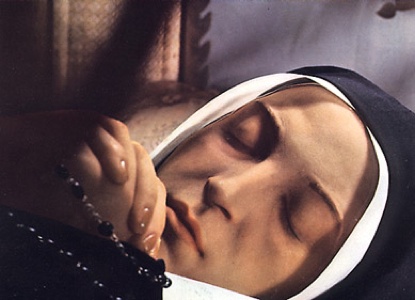
St Bernadette was born Bernadette Soubirous in Lourdes, France. From February to July 1858, she reported eighteen apparitions of “a Lady.” Despite initial skepticism from the Roman Catholic Church, these claims were eventually declared to be worthy of belief after a canonical investigation. After her death, Bernadette’s body remained “incorruptible”, and the shrine at Lourdes went on to become a major site for pilgrimage, attracting millions of Catholics each year.
2. Saint John Vianney, Died 1859
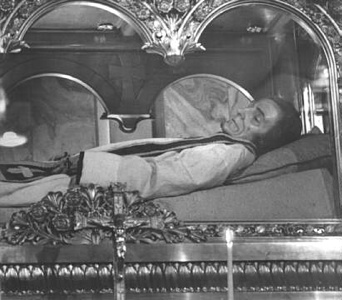
St. Jean Baptiste Marie Vianney (May 8, 1786 – August 4, 1859) was a French parish priest who became a Catholic saint and the patron saint of parish priests. He is often referred to, even in English, as the “Curé d’Ars” (the parish priest of the village of Ars). He became famous internationally for his priestly and pastoral work in his parish due to the radical spiritual transformation of the community and its surroundings.
3. Saint Teresa Margaret, Died 1770
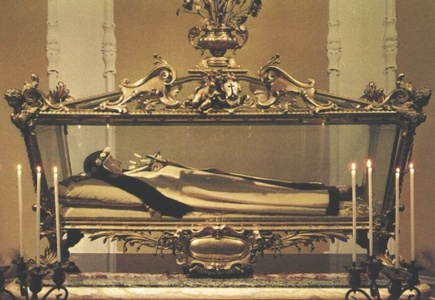
In March 19, 1934, Pope Pius XI entered Blessed Teresa Margaret of the Sacred Heart in the register of saints. In Germany, the new saint is virtually unknown outside of the Carmelite Order. Her life was quiet and hidden. She died on March 7, 1770 at the age of 22, and of this short lifespan, she spent five years in the Carmelite monastery in Florence. She performed no brilliant, attention-getting deeds, nor did her reputation reach the wider world. She spent her life living quietly and with virtue.
Read more on The Incorruptible Saints
Incorruptibility is seen as distinct from the good preservation of a body, or mummification. Incorruptible bodies are often said to have the odour of sanctity, exuding a sweet or floral, pleasant aroma. As of yet, none of these cases has been verified scientifically.
Incorruptibles are the bodies of saints that miraculously do not decay -- even after decades or even a century or more. The bodies often lie in public view in churches and shrines. Saints include: St. Clare of Assisi, St. Vincent De Paul, St. Bernadette Soubirous, St. John Bosco, Blessed Imelda Lambertini, St. Catherine Labouré, and many others. Even the body of Pope John XXIII is reputed to be remarkable well preserved. The case of Blessed Margaret of Metola is recounted in the Fortean Times article, Saints Preserve Us: "She died in 1330, but in 1558 her remains had to be transferred because her coffin was rotting away. Witnesses were amazed to find that like the coffin, the clothes had rotted, but Margaret's crippled body hadn't."
1. Saint Bernadette of Lourdes, Died 1879

St Bernadette was born Bernadette Soubirous in Lourdes, France. From February to July 1858, she reported eighteen apparitions of “a Lady.” Despite initial skepticism from the Roman Catholic Church, these claims were eventually declared to be worthy of belief after a canonical investigation. After her death, Bernadette’s body remained “incorruptible”, and the shrine at Lourdes went on to become a major site for pilgrimage, attracting millions of Catholics each year.
2. Saint John Vianney, Died 1859

St. Jean Baptiste Marie Vianney (May 8, 1786 – August 4, 1859) was a French parish priest who became a Catholic saint and the patron saint of parish priests. He is often referred to, even in English, as the “Curé d’Ars” (the parish priest of the village of Ars). He became famous internationally for his priestly and pastoral work in his parish due to the radical spiritual transformation of the community and its surroundings.
3. Saint Teresa Margaret, Died 1770

In March 19, 1934, Pope Pius XI entered Blessed Teresa Margaret of the Sacred Heart in the register of saints. In Germany, the new saint is virtually unknown outside of the Carmelite Order. Her life was quiet and hidden. She died on March 7, 1770 at the age of 22, and of this short lifespan, she spent five years in the Carmelite monastery in Florence. She performed no brilliant, attention-getting deeds, nor did her reputation reach the wider world. She spent her life living quietly and with virtue.
Read more on The Incorruptible Saints
Monday, December 6, 2010
Hidden Shambhala Mountains
For thousands of years rumors and reports have circulated that somewhere beyond Tibet, among the icy peaks and secluded valleys of Central Asia, there lies an inaccessible paradise, a place of universal wisdom and ineffable peace called Shambhala. Legends say that only the pure of heart can live in Shambhala, enjoying perfect ease and happiness and never knowing suffering, want or old age. Love and wisdom reign and injustice is unknown. The inhabitants are long-lived, wear beautiful and perfect bodies and possess supernatural powers; their spiritual knowledge is deep, their technological level highly advanced, their laws mild and their study of the arts and sciences covers the full spectrum of cultural achievement, but on a far higher level than anything the outside world has attained. By definition Shambhala is hidden. Of the numerous explorers and seekers of spiritual wisdom who attempt to locate Shambhala, none can pinpoint its physical location on a map, although all say it exists in the mountainous regions of Eurasia. Many have also returned believing that Shambhala lies on the very edge of physical reality, as a bridge connecting this world to one beyond it.
In Tibetan Buddhist tradition, Shambhala (also spelled Shambala or Shamballa; Tibetan: bde 'byung, pron. De-jung) is a mythical kingdom hidden somewhere in Inner Asia. It is mentioned in various ancient texts, including the Kalachakra Tantra and the ancient texts of the Zhang Zhung culture which predated Tibetan Buddhism in western Tibet. The Bön scriptures speak of a closely related land called Olmolungring. Whatever its historical basis, Shambhala gradually came to be seen as a Buddhist Pure Land, a fabulous kingdom whose reality is visionary or spiritual as much as physical or geographic. It was in this form that the Shambhala myth reached the West, where it influenced non-Buddhist as well as Buddhist spiritual seekers--and to some extent, popular culture in general. The Sanskrit name means “place of peace, of tranquility.” Though it’s true location has never been found, its beginnings are unknown and its existence is unproven, Shambhala is recognized and honored by at least eight major religions, and is regarded by most esoteric traditions as the true center of the planet and the world’s spiritual powerhouse.
It is said to be inhabited by adepts from every race and culture who form an inner circle that secretly guides human evolution. This remarkable kingdom reputedly exists both above and below ground, with a network of tunnels hundreds of miles long. “Cars of strange design flash along their length,” writes Andrew Tomas, author of Shambhala, Oasis of Light, “and they are illumined by a brilliant, artificial light which affords growth to the grains and vegetables and long life without disease to the people.”
Victoria LePage writes in her superbly researched book, Shambhala: “Modern society is in desperate need of a zone of order, a mandalic center within spiraling chaos.” And she maintains, the quest for this center leads us directly to Shambhala, which she calls “The World Axis.” LePage, who has been studying Shambhala for nearly fifty years, says that many marvels are supposed to have been seen in this underground world: museums, libraries, stores of jewels, and technological inventions thousands of years before their time. And, according to Chinese lore, the aircraft and space vehicles of the Immortals of Shambhala journey among the stars, observing the habitats of other races and kingdoms. It would be easy to dismiss Shambhala as pure mythical fantasy, were it not for a very credible explorer who searched for, found and returned to tell us something about his experiences in Shambhala.
Read more on Shambhala Mountains
In Tibetan Buddhist tradition, Shambhala (also spelled Shambala or Shamballa; Tibetan: bde 'byung, pron. De-jung) is a mythical kingdom hidden somewhere in Inner Asia. It is mentioned in various ancient texts, including the Kalachakra Tantra and the ancient texts of the Zhang Zhung culture which predated Tibetan Buddhism in western Tibet. The Bön scriptures speak of a closely related land called Olmolungring. Whatever its historical basis, Shambhala gradually came to be seen as a Buddhist Pure Land, a fabulous kingdom whose reality is visionary or spiritual as much as physical or geographic. It was in this form that the Shambhala myth reached the West, where it influenced non-Buddhist as well as Buddhist spiritual seekers--and to some extent, popular culture in general. The Sanskrit name means “place of peace, of tranquility.” Though it’s true location has never been found, its beginnings are unknown and its existence is unproven, Shambhala is recognized and honored by at least eight major religions, and is regarded by most esoteric traditions as the true center of the planet and the world’s spiritual powerhouse.
It is said to be inhabited by adepts from every race and culture who form an inner circle that secretly guides human evolution. This remarkable kingdom reputedly exists both above and below ground, with a network of tunnels hundreds of miles long. “Cars of strange design flash along their length,” writes Andrew Tomas, author of Shambhala, Oasis of Light, “and they are illumined by a brilliant, artificial light which affords growth to the grains and vegetables and long life without disease to the people.”
Victoria LePage writes in her superbly researched book, Shambhala: “Modern society is in desperate need of a zone of order, a mandalic center within spiraling chaos.” And she maintains, the quest for this center leads us directly to Shambhala, which she calls “The World Axis.” LePage, who has been studying Shambhala for nearly fifty years, says that many marvels are supposed to have been seen in this underground world: museums, libraries, stores of jewels, and technological inventions thousands of years before their time. And, according to Chinese lore, the aircraft and space vehicles of the Immortals of Shambhala journey among the stars, observing the habitats of other races and kingdoms. It would be easy to dismiss Shambhala as pure mythical fantasy, were it not for a very credible explorer who searched for, found and returned to tell us something about his experiences in Shambhala.
Read more on Shambhala Mountains
The Sleeping Prophet
Born in Kentucky 1877, Edgar Cayce was known as “the Sleeping Prophet,” because he uttered predictions and medical cures while in a deep trance. Until his death in Virginia, 68 years later, Cayce dictated thousands of “life-readings” he allegedly obtained from a kind of spiritual record he claimed to be able to read while experiencing an altered state of consciousness. Until his 47th year, he never uttered a word about Atlantis. But in 1922, he suddenly began recalling life in a place with which he was otherwise allegedly unfamiliar. Cayce said that his trance statements should be taken into account only to the extent that they led to a better life for the recipient. Moreover, he invited his audience to test his suggestions rather than accept them on faith. Other abilities that have been attributed to Cayce include astral projection, prophesying, mediumship, viewing the Akashic Records or "Book of Life", and seeing auras. Cayce said he became interested in learning more about these subjects after he was informed about the content of his readings, which he reported that he never actually heard himself.
Cayce’s descriptions of the doomed civilization are sometimes remarkable for their uncanny credibility. For example, his portrayal of the migration of Atlanteans into the Nile Valley following the destruction of their Empire is entirely convincing. Many otherwise obscure names of persons and places he associates with the Atlantis experience likewise seem to reflect real events. His son, Hugh Lynn Cayce, knew his father “did not read material on Atlantis, and that he, so far as we know, had absolutely no knowledge of the subject.” The evocative, often verifiable detail of his readings in which Atlantis was described is all the more astounding when we realize he knew little about the vanished culture in his waking hours. As his son wrote: They are the most fantastic, the most bizarre, the most impossible information in the Edgar Cayce files. If his unconscious fabricated this material or wove it together from existing legends and writings, we believe that it is the most amazing example of a telepathic-clairvoyant scanning of existing legends and stories in print or of the minds of persons dealing with the Atlantis theory.
Edgar Cayce’s conscious ignorance of the sunken civilization is not surprising. His formal education was meager, and his points of reference were more spiritual than historical or academic. His grasp of the past was often biblical, rather than scholastic. It seems clear then, that the subject was outside the purview of both his background and essentially Christian view of the world. But his readings are selfevidently plausible, because they often contain information that made little or no sense at the time they were uttered, but have been since confirmed by subsequent verification.
Perhaps most impressive of all is that obscure, even fleeting, references he made to Atlantis during the early 1920s were occasionally repeated only once, but within an exact same frame of reference, after more than two decades. Persuasive as these give even skeptics pause, and encourage many investigators, regardless of their spiritual beliefs, to reconsider everything he had to say about Atlantis. His prediction of finding its first physical remains not far from the United States was a case in point described in the “Bimini” entry. Until Cayce spoke of Bimini, and even long after some of his “life-readings” were published, no researchers bothered to consider that small island as a possible remnant of Atlantean Civilization. But how did the massive stone structure come to lie at the bottom of the sea? According to Cayce’s “life-readings,” the Atlantean lands underwent three major periods of inundation. They did not disappear altogether in a single cataclysm. The natural disaster described by Plato represented only the final destruction of Atlantis.
Read more on The Sleeping Prophet
Cayce’s descriptions of the doomed civilization are sometimes remarkable for their uncanny credibility. For example, his portrayal of the migration of Atlanteans into the Nile Valley following the destruction of their Empire is entirely convincing. Many otherwise obscure names of persons and places he associates with the Atlantis experience likewise seem to reflect real events. His son, Hugh Lynn Cayce, knew his father “did not read material on Atlantis, and that he, so far as we know, had absolutely no knowledge of the subject.” The evocative, often verifiable detail of his readings in which Atlantis was described is all the more astounding when we realize he knew little about the vanished culture in his waking hours. As his son wrote: They are the most fantastic, the most bizarre, the most impossible information in the Edgar Cayce files. If his unconscious fabricated this material or wove it together from existing legends and writings, we believe that it is the most amazing example of a telepathic-clairvoyant scanning of existing legends and stories in print or of the minds of persons dealing with the Atlantis theory.
Edgar Cayce’s conscious ignorance of the sunken civilization is not surprising. His formal education was meager, and his points of reference were more spiritual than historical or academic. His grasp of the past was often biblical, rather than scholastic. It seems clear then, that the subject was outside the purview of both his background and essentially Christian view of the world. But his readings are selfevidently plausible, because they often contain information that made little or no sense at the time they were uttered, but have been since confirmed by subsequent verification.
Perhaps most impressive of all is that obscure, even fleeting, references he made to Atlantis during the early 1920s were occasionally repeated only once, but within an exact same frame of reference, after more than two decades. Persuasive as these give even skeptics pause, and encourage many investigators, regardless of their spiritual beliefs, to reconsider everything he had to say about Atlantis. His prediction of finding its first physical remains not far from the United States was a case in point described in the “Bimini” entry. Until Cayce spoke of Bimini, and even long after some of his “life-readings” were published, no researchers bothered to consider that small island as a possible remnant of Atlantean Civilization. But how did the massive stone structure come to lie at the bottom of the sea? According to Cayce’s “life-readings,” the Atlantean lands underwent three major periods of inundation. They did not disappear altogether in a single cataclysm. The natural disaster described by Plato represented only the final destruction of Atlantis.
Read more on The Sleeping Prophet
Subscribe to:
Comments (Atom)


